Part 2 面向对象
Lecture 7 类&对象
目录
1类&对象
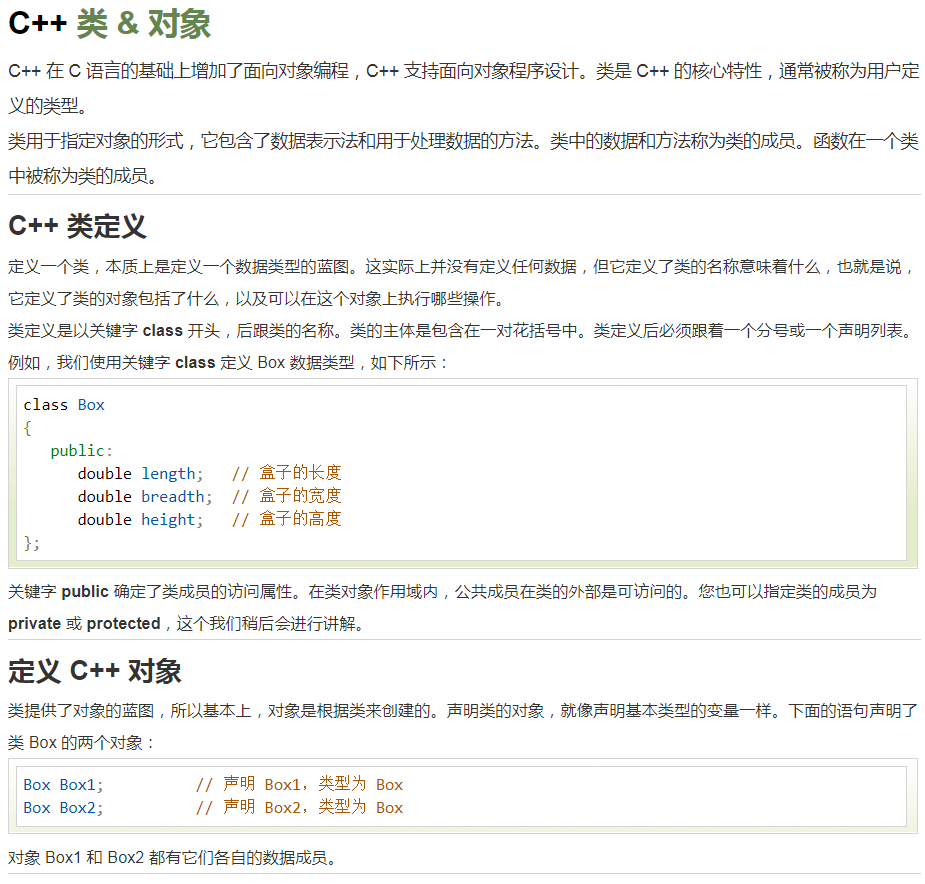
#include <iostream>
using namespace std;
class Box
{
public:
double length; // 长度
double breadth; // 宽度
double height; // 高度
};
int main( )
{
Box Box1; // 声明 Box1,类型为 Box
Box Box2; // 声明 Box2,类型为 Box
double volume = 0.0; // 用于存储体积
// box 1 详述
Box1.height = 5.0;
Box1.length = 6.0;
Box1.breadth = 7.0;
// box 2 详述
Box2.height = 10.0;
Box2.length = 12.0;
Box2.breadth = 13.0;
// box 1 的体积
volume = Box1.height * Box1.length * Box1.breadth;
cout << "Box1 的体积:" << volume <<endl;
// box 2 的体积
volume = Box2.height * Box2.length * Box2.breadth;
cout << "Box2 的体积:" << volume <<endl;
return 0;
}当上面的代码被编译和执行时,它会产生下列结果:
Box1 的体积:210
Box2 的体积:1560
需要注意的是,私有的成员和受保护的成员不能使用直接成员访问运算符 (.) 来直接访问。
我们将在后续的教程中学习如何访问私有成员和受保护的成员。
1.1类成员函数
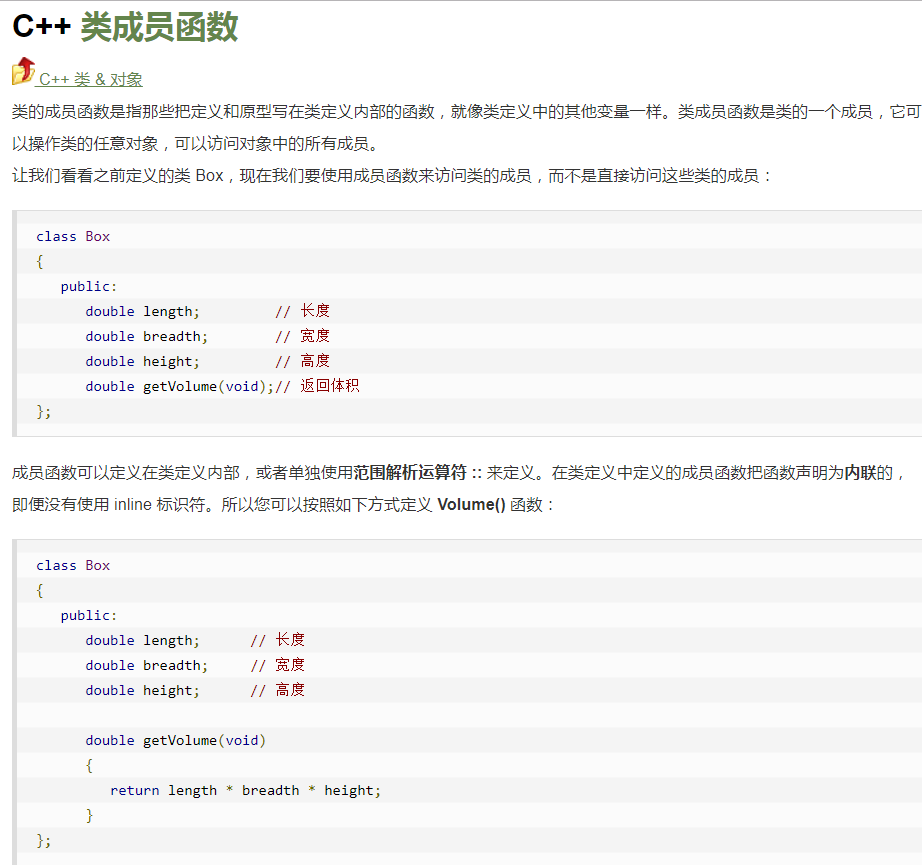
#include <iostream>
using namespace std;
class Box
{
public:
double length; // 长度
double breadth; // 宽度
double height; // 高度
// 成员函数声明
double getVolume(void);
void setLength( double len );
void setBreadth( double bre );
void setHeight( double hei );
};
// 成员函数定义
double Box::getVolume(void)
{
return length * breadth * height;
}
void Box::setLength( double len )
{
length = len;
}
void Box::setBreadth( double bre )
{
breadth = bre;
}
void Box::setHeight( double hei )
{
height = hei;
}
// 程序的主函数
int main( )
{
Box Box1; // 声明 Box1,类型为 Box
Box Box2; // 声明 Box2,类型为 Box
double volume = 0.0; // 用于存储体积
// box 1 详述
Box1.setLength(6.0);
Box1.setBreadth(7.0);
Box1.setHeight(5.0);
// box 2 详述
Box2.setLength(12.0);
Box2.setBreadth(13.0);
Box2.setHeight(10.0);
// box 1 的体积
volume = Box1.getVolume();
cout << "Box1 的体积:" << volume <<endl;
// box 2 的体积
volume = Box2.getVolume();
cout << "Box2 的体积:" << volume <<endl;
return 0;
}当上面的代码被编译和执行时,它会产生下列结果:
Box1 的体积: 210
Box2 的体积: 1560
:: 叫作用域区分符,指明一个函数属于哪个类或一个数据属于哪个类。
:: 可以不跟类名,表示全局数据或全局函数(即非成员函数)。
1.2类访问修饰符
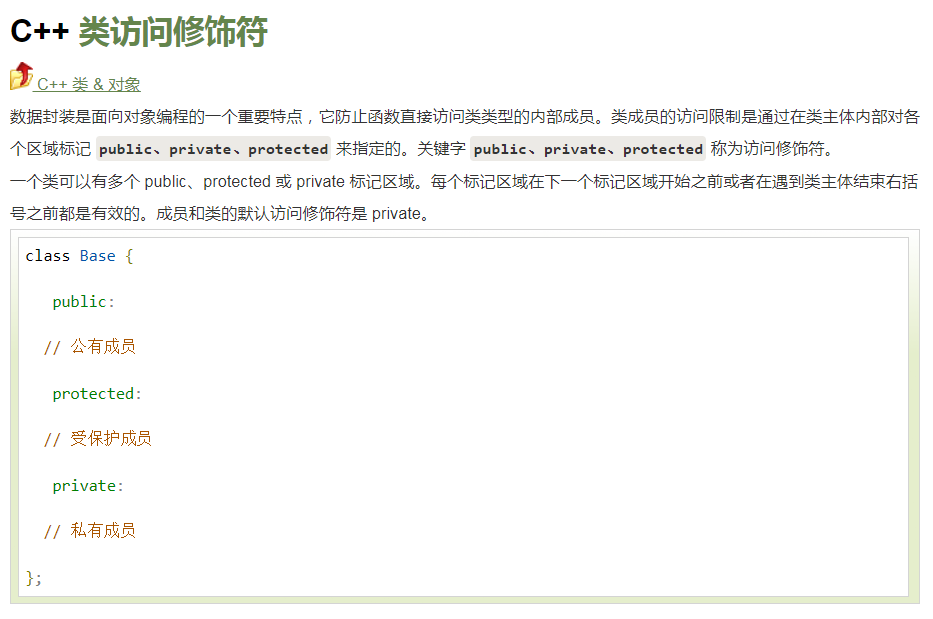
公有成员Public
公有成员在程序中类的外部是可访问的。您可以不使用任何成员函数来设置和获取公有变量的值,如下所示:
#include <iostream>
using namespace std;
class Line
{
public:
double length;
void setLength( double len );
double getLength( void );
};
// 成员函数定义
double Line::getLength(void)
{
return length ;
}
void Line::setLength( double len )
{
length = len;
}
// 程序的主函数
int main( )
{
Line line;
// 设置长度
line.setLength(6.0);
cout << "Length of line : " << line.getLength() <<endl;
// 不使用成员函数设置长度
line.length = 10.0; // OK: 因为 length 是公有的
cout << "Length of line : " << line.length <<endl;
return 0;
}当上面的代码被编译和执行时,它会产生下列结果:
Length of line : 6
Length of line : 10
私有成员Private
私有成员变量或函数在类的外部是不可访问的,甚至是不可查看的。只有类和友元函数可以访问私有成员。
默认情况下,类的所有成员都是私有的。例如在下面的类中,width 是一个私有成员,这意味着,如果您没有使用任何访问修饰符,类的成员将被假定为私有成员:
class Box
{
double width;
public:
double length;
void setWidth( double wid );
double getWidth( void );
};实际操作中,我们一般会在私有区域定义数据,在公有区域定义相关的函数,以便在类的外部也可以调用这些函数,如下所示:
#include <iostream>
using namespace std;
class Box
{
public:
double length;
void setWidth( double wid );
double getWidth( void );
private:
double width;
};
// 成员函数定义
double Box::getWidth(void)
{
return width ;
}
void Box::setWidth( double wid )
{
width = wid;
}
// 程序的主函数
int main( )
{
Box box;
// 不使用成员函数设置长度
box.length = 10.0; // OK: 因为 length 是公有的
cout << "Length of box : " << box.length <<endl;
// 不使用成员函数设置宽度
// box.width = 10.0; // Error: 因为 width 是私有的
box.setWidth(10.0); // 使用成员函数设置宽度
cout << "Width of box : " << box.getWidth() <<endl;
return 0;
}当上面的代码被编译和执行时,它会产生下列结果:
Length of box : 10
Width of box : 10
保护成员Protected
保护成员变量或函数与私有成员十分相似,但有一点不同,保护成员在派生类(即子类)中是可访问的。
在下一个章节中,您将学习到派生类和继承的知识。现在您可以看到下面的实例中,我们从父类 Box 派生了一个子类 smallBox。
下面的实例与前面的实例类似,在这里 width 成员可被派生类 smallBox 的任何成员函数访问。
#include <iostream>
using namespace std;
class Box
{
protected:
double width;
};
class SmallBox:Box // SmallBox 是派生类
{
public:
void setSmallWidth( double wid );
double getSmallWidth( void );
};
// 子类的成员函数
double SmallBox::getSmallWidth(void)
{
return width ;
}
void SmallBox::setSmallWidth( double wid )
{
width = wid;
}
// 程序的主函数
int main( )
{
SmallBox box;
// 使用成员函数设置宽度
box.setSmallWidth(5.0);
cout << "Width of box : "<< box.getSmallWidth() << endl;
return 0;
}当上面的代码被编译和执行时,它会产生下列结果:
Width of box : 5
#include<iostream>
#include<assert.h>
using namespace std;
class A{
public:
int a;
A(){
a1 = 1;
a2 = 2;
a3 = 3;
a = 4;
}
void fun(){
cout << a << endl; //正确
cout << a1 << endl; //正确
cout << a2 << endl; //正确
cout << a3 << endl; //正确
}
public:
int a1;
protected:
int a2;
private:
int a3;
};
class B : public A{
public:
int a;
B(int i){
A();
a = i;
}
void fun(){
cout << a << endl; //正确,public成员
cout << a1 << endl; //正确,基类的public成员,在派生类中仍是public成员。
cout << a2 << endl; //正确,基类的protected成员,在派生类中仍是protected可以被派生类访问。
cout << a3 << endl; //错误,基类的private成员不能被派生类访问。
}
};
int main(){
B b(10);
cout << b.a << endl;
cout << b.a1 << endl; //正确
cout << b.a2 << endl; //错误,类外不能访问protected成员
cout << b.a3 << endl; //错误,类外不能访问private成员
system("pause");
return 0;
}10
1
sh: 1: pause: not found
protected 继承
#include<iostream>
#include<assert.h>
using namespace std;
class A{
public:
int a;
A(){
a1 = 1;
a2 = 2;
a3 = 3;
a = 4;
}
void fun(){
cout << a << endl; //正确
cout << a1 << endl; //正确
cout << a2 << endl; //正确
cout << a3 << endl; //正确
}
public:
int a1;
protected:
int a2;
private:
int a3;
};
class B : protected A{
public:
int a;
B(int i){
A();
a = i;
}
void fun(){
cout << a << endl; //正确,public成员。
cout << a1 << endl; //正确,基类的public成员,在派生类中变成了protected,可以被派生类访问。
cout << a2 << endl; //正确,基类的protected成员,在派生类中还是protected,可以被派生类访问。
cout << a3 << endl; //错误,基类的private成员不能被派生类访问。
}
};
int main(){
B b(10);
cout << b.a << endl; //正确。public成员
cout << b.a1 << endl; //错误,protected成员不能在类外访问。
cout << b.a2 << endl; //错误,protected成员不能在类外访问。
cout << b.a3 << endl; //错误,private成员不能在类外访问。
system("pause");
return 0;
}private 继承
#include<iostream>
#include<assert.h>
using namespace std;
class A{
public:
int a;
A(){
a1 = 1;
a2 = 2;
a3 = 3;
a = 4;
}
void fun(){
cout << a << endl; //正确
cout << a1 << endl; //正确
cout << a2 << endl; //正确
cout << a3 << endl; //正确
}
public:
int a1;
protected:
int a2;
private:
int a3;
};
class B : private A{
public:
int a;
B(int i){
A();
a = i;
}
void fun(){
cout << a << endl; //正确,public成员。
cout << a1 << endl; //正确,基类public成员,在派生类中变成了private,可以被派生类访问。
cout << a2 << endl; //正确,基类的protected成员,在派生类中变成了private,可以被派生类访问。
cout << a3 << endl; //错误,基类的private成员不能被派生类访问。
}
};
int main(){
B b(10);
cout << b.a << endl; //正确。public成员
cout << b.a1 << endl; //错误,private成员不能在类外访问。
cout << b.a2 << endl; //错误, private成员不能在类外访问。
cout << b.a3 << endl; //错误,private成员不能在类外访问。
system("pause");
return 0;
}1.3构造函数&析构函数
#include <iostream>
using namespace std;
class Line
{
public:
void setLength( double len );
double getLength( void );
Line(); // 这是构造函数
private:
double length;
};
// 成员函数定义,包括构造函数
Line::Line(void)
{
cout << "Object is being created" << endl;
}
void Line::setLength( double len )
{
length = len;
}
double Line::getLength( void )
{
return length;
}
// 程序的主函数
int main( )
{
Line line;
// 设置长度
line.setLength(6.0);
cout << "Length of line : " << line.getLength() <<endl;
return 0;
}当上面的代码被编译和执行时,它会产生下列结果:
Object is being created
Length of line : 6
带参数的构造函数
默认的构造函数没有任何参数,但如果需要,构造函数也可以带有参数。这样在创建对象时就会给对象赋初始值,如下面的例子所示:
#include <iostream>
using namespace std;
class Line
{
public:
void setLength( double len );
double getLength( void );
Line(double len); // 这是构造函数
private:
double length;
};
// 成员函数定义,包括构造函数
Line::Line( double len)
{
cout << "Object is being created, length = " << len << endl;
length = len;
}
void Line::setLength( double len )
{
length = len;
}
double Line::getLength( void )
{
return length;
}
// 程序的主函数
int main( )
{
Line line(10.0);
// 获取默认设置的长度
cout << "Length of line : " << line.getLength() <<endl;
// 再次设置长度
line.setLength(6.0);
cout << "Length of line : " << line.getLength() <<endl;
return 0;
}当上面的代码被编译和执行时,它会产生下列结果:
Object is being created, length = 10
Length of line : 10
Length of line : 6
类的析构函数
类的析构函数是类的一种特殊的成员函数,它会在每次删除所创建的对象时执行。
析构函数的名称与类的名称是完全相同的,只是在前面加了个波浪号(~)作为前缀,它不会返回任何值,也不能带有任何参数。析构函数有助于在跳出程序(比如关闭文件、释放内存等)前释放资源。
下面的实例有助于更好地理解析构函数的概念:
#include <iostream>
using namespace std;
class Line
{
public:
void setLength( double len );
double getLength( void );
Line(); // 这是构造函数声明
~Line(); // 这是析构函数声明
private:
double length;
};
// 成员函数定义,包括构造函数
Line::Line(void)
{
cout << "Object is being created" << endl;
}
Line::~Line(void)
{
cout << "Object is being deleted" << endl;
}
void Line::setLength( double len )
{
length = len;
}
double Line::getLength( void )
{
return length;
}
// 程序的主函数
int main( )
{
Line line;
// 设置长度
line.setLength(6.0);
cout << "Length of line : " << line.getLength() <<endl;
return 0;
}当上面的代码被编译和执行时,它会产生下列结果:
Object is being created
Length of line : 6
Object is being deleted
1.4拷贝构造函数
#include <iostream>
using namespace std;
class Line
{
public:
int getLength( void );
Line( int len ); // 简单的构造函数
Line( const Line &obj); // 拷贝构造函数
~Line(); // 析构函数
private:
int *ptr;
};
// 成员函数定义,包括构造函数
Line::Line(int len)
{
cout << "调用构造函数" << endl;
// 为指针分配内存
ptr = new int;
*ptr = len;
}
Line::Line(const Line &obj)
{
cout << "调用拷贝构造函数并为指针 ptr 分配内存" << endl;
ptr = new int;
*ptr = *obj.ptr; // 拷贝值
}
Line::~Line(void)
{
cout << "释放内存" << endl;
delete ptr;
}
int Line::getLength( void )
{
return *ptr;
}
void display(Line obj)
{
cout << "line 大小 : " << obj.getLength() <<endl;
}
// 程序的主函数
int main( )
{
Line line(10);
display(line);
return 0;
}当上面的代码被编译和执行时,它会产生下列结果:
调用构造函数
调用拷贝构造函数并为指针 ptr 分配内存
line 大小 : 10
释放内存
释放内存
下面的实例对上面的实例稍作修改,通过使用已有的同类型的对象来初始化新创建的对象:
#include <iostream>
using namespace std;
class Line
{
public:
int getLength( void );
Line( int len ); // 简单的构造函数
Line( const Line &obj); // 拷贝构造函数
~Line(); // 析构函数
private:
int *ptr;
};
// 成员函数定义,包括构造函数
Line::Line(int len)
{
cout << "调用构造函数" << endl;
// 为指针分配内存
ptr = new int;
*ptr = len;
}
Line::Line(const Line &obj)
{
cout << "调用拷贝构造函数并为指针 ptr 分配内存" << endl;
ptr = new int;
*ptr = *obj.ptr; // 拷贝值
}
Line::~Line(void)
{
cout << "释放内存" << endl;
delete ptr;
}
int Line::getLength( void )
{
return *ptr;
}
void display(Line obj)
{
cout << "line 大小 : " << obj.getLength() <<endl;
}
// 程序的主函数
int main( )
{
Line line1(10);
Line line2 = line1; // 这里也调用了拷贝构造函数
display(line1);
display(line2);
return 0;
}当上面的代码被编译和执行时,它会产生下列结果:
调用构造函数
调用拷贝构造函数并为指针 ptr 分配内存
调用拷贝构造函数并为指针 ptr 分配内存
line 大小 : 10
释放内存
调用拷贝构造函数并为指针 ptr 分配内存
line 大小 : 10
释放内存
释放内存
释放内存
1.5友元函数
#include <iostream>
using namespace std;
class Box
{
double width;
public:
friend void printWidth( Box box );
void setWidth( double wid );
};
// 成员函数定义
void Box::setWidth( double wid )
{
width = wid;
}
// 请注意:printWidth() 不是任何类的成员函数
void printWidth( Box box )
{
/* 因为 printWidth() 是 Box 的友元,它可以直接访问该类的任何成员 */
cout << "Width of box : " << box.width <<endl;
}
// 程序的主函数
int main( )
{
Box box;
// 使用成员函数设置宽度
box.setWidth(10.0);
// 使用友元函数输出宽度
printWidth( box );
return 0;
}当上面的代码被编译和执行时,它会产生下列结果:
Width of box : 10
1.6内联函数
#include <iostream>
using namespace std;
inline int Max(int x, int y)
{
return (x > y)? x : y;
}
// 程序的主函数
int main( )
{
cout << "Max (20,10): " << Max(20,10) << endl;
cout << "Max (0,200): " << Max(0,200) << endl;
cout << "Max (100,1010): " << Max(100,1010) << endl;
return 0;
}当上面的代码被编译和执行时,它会产生下列结果:
Max (20,10): 20
Max (0,200): 200
Max (100,1010): 1010
1.7this指针
#include <iostream>
using namespace std;
class Box
{
public:
// 构造函数定义
Box(double l=2.0, double b=2.0, double h=2.0)
{
cout <<"Constructor called." << endl;
length = l;
breadth = b;
height = h;
}
double Volume()
{
return length * breadth * height;
}
int compare(Box box)
{
return this->Volume() > box.Volume();
}
private:
double length; // Length of a box
double breadth; // Breadth of a box
double height; // Height of a box
};
int main(void)
{
Box Box1(3.3, 1.2, 1.5); // Declare box1
Box Box2(8.5, 6.0, 2.0); // Declare box2
if(Box1.compare(Box2))
{
cout << "Box2 is smaller than Box1" <<endl;
}
else
{
cout << "Box2 is equal to or larger than Box1" <<endl;
}
return 0;
}当上面的代码被编译和执行时,它会产生下列结果:
Constructor called.
Constructor called.
Box2 is equal to or larger than Box1
1.8指向类的指针
一个指向 C++ 类的指针与指向结构的指针类似,访问指向类的指针的成员,需要使用成员访问运算符 ->,就像访问指向结构的指针一样。与所有的指针一样,您必须在使用指针之前,对指针进行初始化。
下面的实例有助于更好地理解指向类的指针的概念:
#include <iostream>
using namespace std;
class Box
{
public:
// 构造函数定义
Box(double l=2.0, double b=2.0, double h=2.0)
{
cout <<"Constructor called." << endl;
length = l;
breadth = b;
height = h;
}
double Volume()
{
return length * breadth * height;
}
private:
double length; // Length of a box
double breadth; // Breadth of a box
double height; // Height of a box
};
int main(void)
{
Box Box1(3.3, 1.2, 1.5); // Declare box1
Box Box2(8.5, 6.0, 2.0); // Declare box2
Box *ptrBox; // Declare pointer to a class.
// 保存第一个对象的地址
ptrBox = &Box1;
// 现在尝试使用成员访问运算符来访问成员
cout << "Volume of Box1: " << ptrBox->Volume() << endl;
// 保存第二个对象的地址
ptrBox = &Box2;
// 现在尝试使用成员访问运算符来访问成员
cout << "Volume of Box2: " << ptrBox->Volume() << endl;
return 0;
}当上面的代码被编译和执行时,它会产生下列结果:
Constructor called.
Constructor called.
Volume of Box1: 5.94
Volume of Box2: 102
1.9类的静态成员
我们可以使用 static 关键字来把类成员定义为静态的。当我们声明类的成员为静态时,这意味着无论创建多少个类的对象,静态成员都只有一个副本。
静态成员在类的所有对象中是共享的。如果不存在其他的初始化语句,在创建第一个对象时,所有的静态数据都会被初始化为零。我们不能把静态成员的初始化放置在类的定义中,但是可以在类的外部通过使用范围解析运算符 :: 来重新声明静态变量从而对它进行初始化,如下面的实例所示。
下面的实例有助于更好地理解静态成员数据的概念:
#include <iostream>
using namespace std;
class Box
{
public:
static int objectCount;
// 构造函数定义
Box(double l=2.0, double b=2.0, double h=2.0)
{
cout <<"Constructor called." << endl;
length = l;
breadth = b;
height = h;
// 每次创建对象时增加 1
objectCount++;
}
double Volume()
{
return length * breadth * height;
}
private:
double length; // 长度
double breadth; // 宽度
double height; // 高度
};
// 初始化类 Box 的静态成员
int Box::objectCount = 0;
int main(void)
{
Box Box1(3.3, 1.2, 1.5); // 声明 box1
Box Box2(8.5, 6.0, 2.0); // 声明 box2
// 输出对象的总数
cout << "Total objects: " << Box::objectCount << endl;
return 0;
}当上面的代码被编译和执行时,它会产生下列结果:
Constructor called.
Constructor called.
Total objects: 2
静态成员函数
#include <iostream>
using namespace std;
class Box
{
public:
static int objectCount;
// 构造函数定义
Box(double l=2.0, double b=2.0, double h=2.0)
{
cout <<"Constructor called." << endl;
length = l;
breadth = b;
height = h;
// 每次创建对象时增加 1
objectCount++;
}
double Volume()
{
return length * breadth * height;
}
static int getCount()
{
return objectCount;
}
private:
double length; // 长度
double breadth; // 宽度
double height; // 高度
};
// 初始化类 Box 的静态成员
int Box::objectCount = 0;
int main(void)
{
// 在创建对象之前输出对象的总数
cout << "Inital Stage Count: " << Box::getCount() << endl;
Box Box1(3.3, 1.2, 1.5); // 声明 box1
Box Box2(8.5, 6.0, 2.0); // 声明 box2
// 在创建对象之后输出对象的总数
cout << "Final Stage Count: " << Box::getCount() << endl;
return 0;
}当上面的代码被编译和执行时,它会产生下列结果:
Inital Stage Count: 0
Constructor called.
Constructor called.
Final Stage Count: 2
静态成员变量在类中仅仅是声明,没有定义,所以要在类的外面定义,实际上是给静态成员变量分配内存。如果不加定义就会报错,初始化是赋一个初始值,而定义是分配内存。









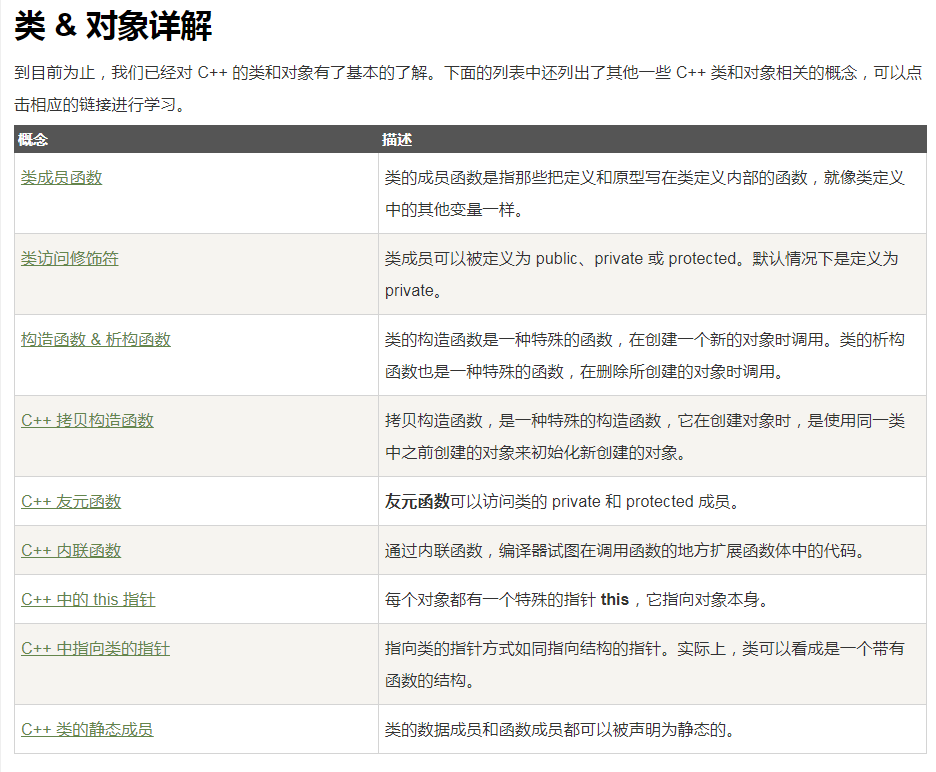
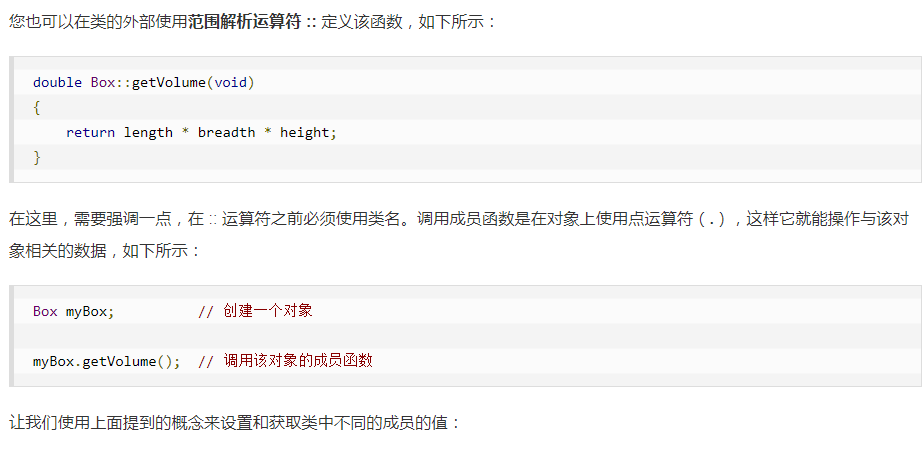


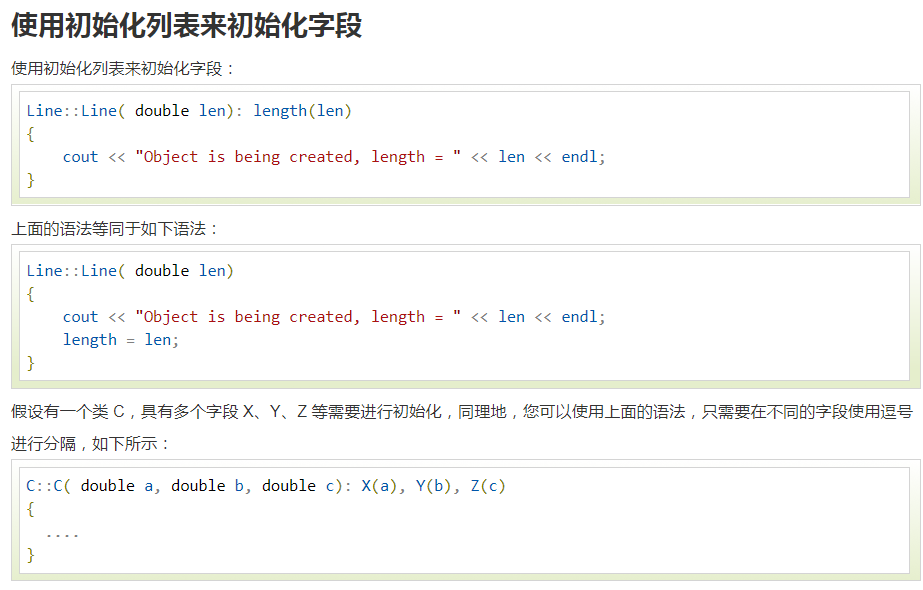
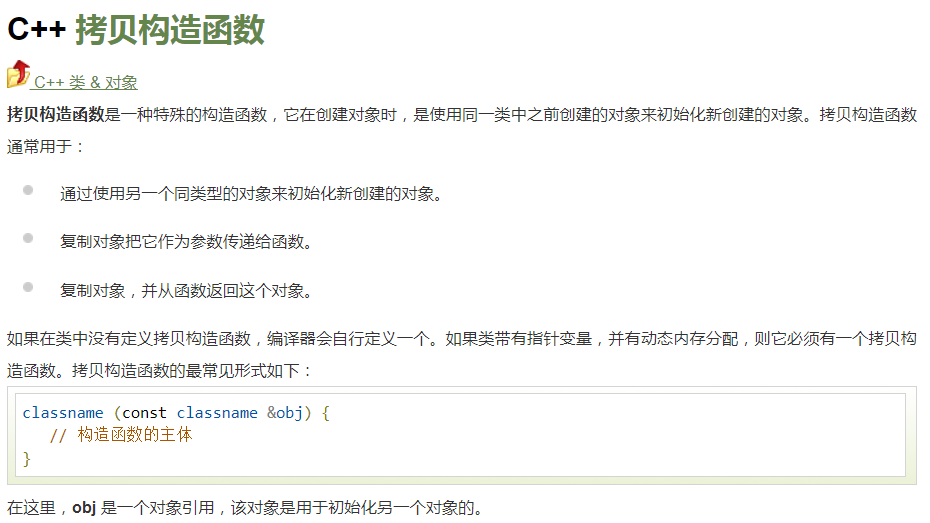
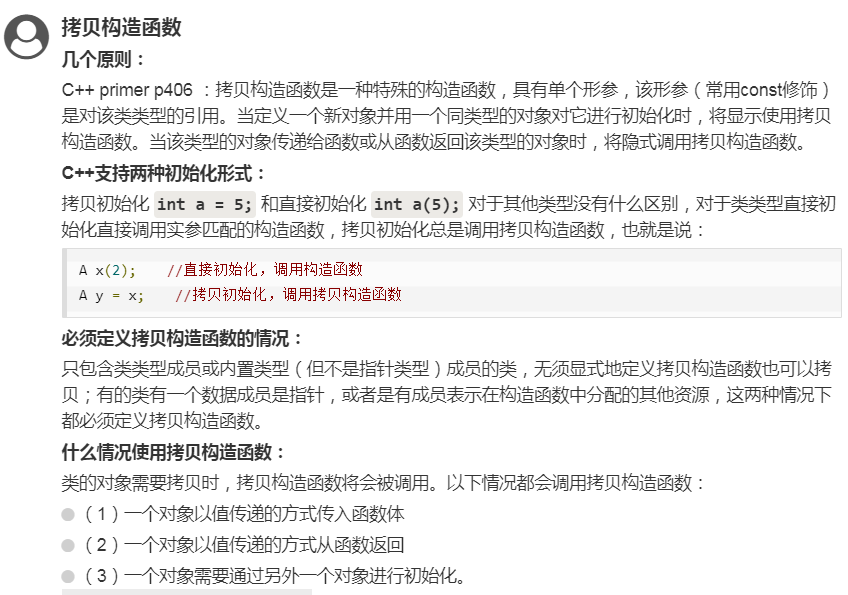
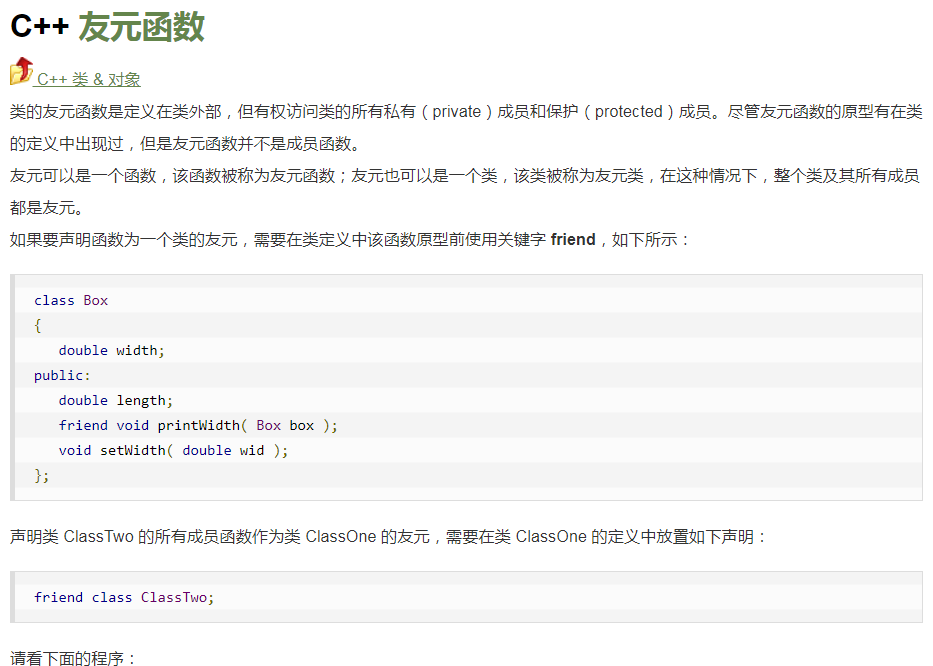
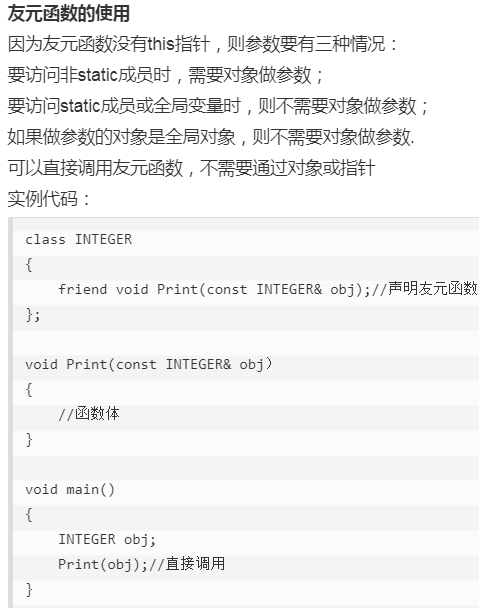
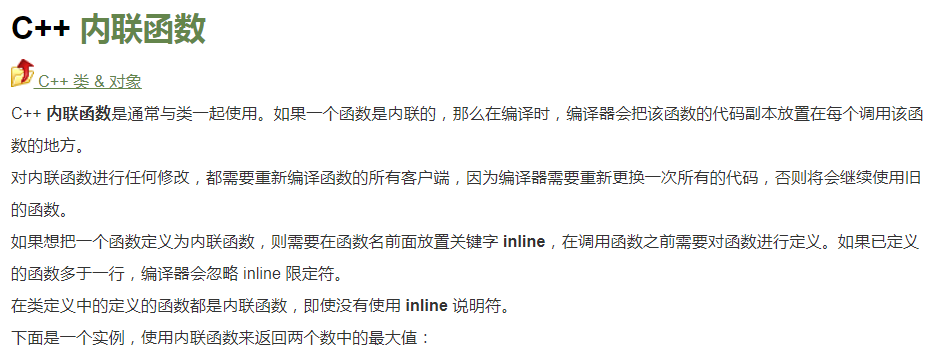


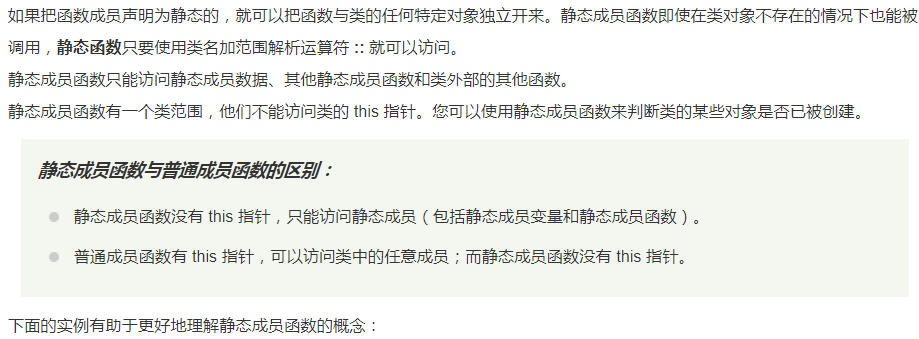
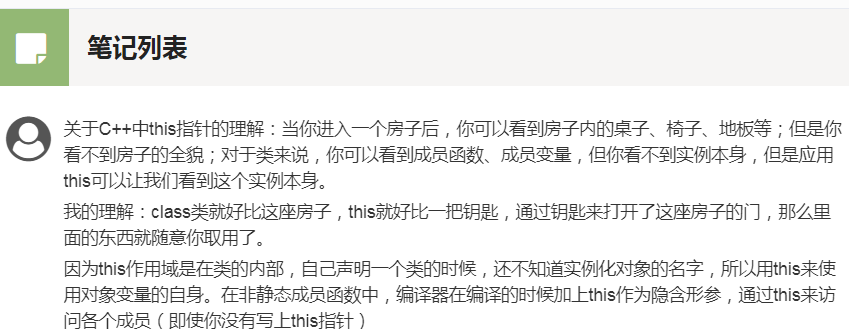















 1万+
1万+

 被折叠的 条评论
为什么被折叠?
被折叠的 条评论
为什么被折叠?








